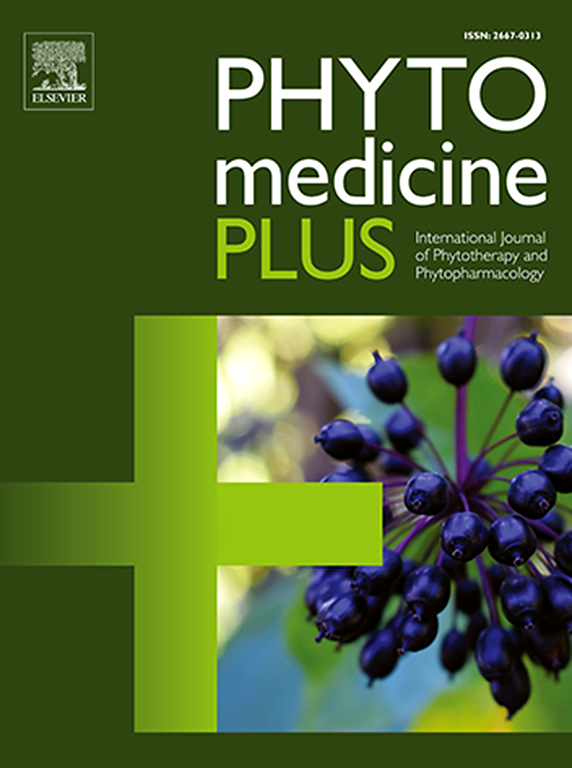小茴香果汁对高卢蛔虫和猪蛔虫的抗氧化和驱虫活性
Q3 Pharmacology, Toxicology and Pharmaceutics
引用次数: 0
摘要
背景加利蛔虫和猪蛔虫是导致家禽和猪寄生虫病的主要原因。虽然a.g oli很少感染人类而不引起重大疾病,但a.g umum是一种人畜共患寄生虫,由于幼虫的迁移,能够引起人类肺部不适。今天,驱虫药治疗仍然是必不可少的,特别是使用尚未深入探索的草药,包括在印度尼西亚各地广泛发现的Syzygium cumini(俗称:黑梅果;当地名称:jamun)的果实。目的研究小茴香果汁的抗氧化活性、抗脂肪酶活性和除虫活性。方法采用DPPH自由基清除法、IC50测定法和总酚含量(TPC)法测定其抗氧化活性。采用液相色谱-质谱法测定果汁中的主要生物活性成分。采用琼脂孔扩散法评估抗脂肪酶活性,并通过体外测定34.06、68.12、102.18和136.24 mg/ml浓度下的A. galli和A. suum与20 mg/ml吡喃吡酯(Combantrin®)的驱虫效果进行比较。结果提取液DPPH的IC50值为2.06µg/ml,强于丁基羟基甲苯(BHT);此外,果汁还显示出抗脂肪酶活性,表明其与解决脂质代谢紊乱有关。结果表明,在102.18 mg/ml和136.24 mg/ml浓度下,两种寄生虫均有明显的麻痹和死亡率。Cumini果汁显示出显著的抗氧化、抗脂肪酶和驱虫潜能。这些发现表明,南瓜果汁可能是一种很有希望的治疗寄生虫病的天然替代品,值得进一步研究。本文章由计算机程序翻译,如有差异,请以英文原文为准。
Antioxidant and anthelmintic activity of Syzygium cumini fruit juice against Ascaridia galli and Ascaris suum
Background
Ascaridia galli and Ascaris suum are the leading causes of helminthiasis in poultry and pigs. While A. galli rarely infects humans without causing significant disease, A. suum is a zoonotic parasite capable of causing pulmonary discomfort in human beings, due to larval migration. Today, anthelmintic therapy remains essential, particularly the use of herbal medicine that has not yet been intensively explored, including the fruit of Syzygium cumini (common name: black plum fruit; local name: jamun), which is widely found throughout Indonesia.
Purpose
This study evaluates the S. cumini fruit juice for its antioxidant, antilipase, and anthelmintic activities against A. galli and A. suum.
Methods
Antioxidant activity was assessed using DPPH radical scavenging assay, IC50 determination, and total phenolic content (TPC) analysis. LC-MS analysis was performed to determine major bioactive compounds in the fruit juice. Antilipase activity was evaluated using an agar well diffusion method, and anthelmintic effects were assessed through in vitro assays on A. galli and A. suum at concentrations of 34.06, 68.12, 102.18, and 136.24 mg/ml, compared with pyrantel pamoate (Combantrin®) at 20 mg/ml.
Results
The DPPH assay of the extracts exhibited an IC50 2.06 µg/ml, stronger than the butylated hydroxytoluene (BHT). In addition, the fruit juice also demonstrated antilipase activity, indicating its relevance in addressing lipid metabolism disorders. The anthelmintic activity was carried out which showed significant worm paralysis and mortality in both parasites especially at 102.18, and 136.24 mg/ml.
Conclusion
S. cumini fruit juice demonstrated significant antioxidant, antilipase, and anthelmintic potential. These findings suggest that S. cumini fruit juice could be a promising natural alternative for helminthiasis treatment, warranting further investigation.
求助全文
通过发布文献求助,成功后即可免费获取论文全文。
去求助
来源期刊

Phytomedicine Plus
Medicine-Complementary and Alternative Medicine
CiteScore
3.70
自引率
0.00%
发文量
178
审稿时长
81 days
期刊介绍:
 求助内容:
求助内容: 应助结果提醒方式:
应助结果提醒方式:


